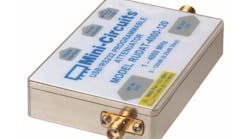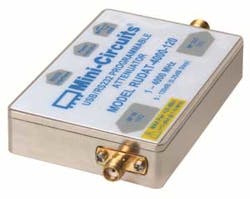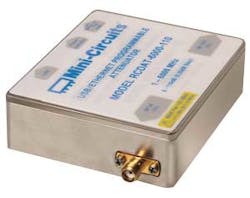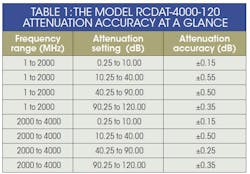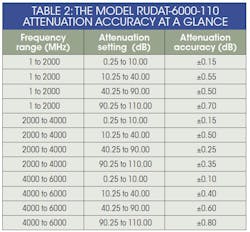This file type includes high resolution graphics and schematics when applicable.
Attenuation is an important electrical characteristic for a wide range of applications, from communications networks to measurement systems. Attenuators come in many shapes and sizes, ranging from tiny fixed components to large instruments. As a practical compromise in size—but not in performance—a pair of new programmable attenuators from Mini-Circuits operate over broad bandwidths as wide as 1 to 6000 MHz, with 110-dB or more precisely controlled attenuation that is adjustable in fine 0.25-dB steps.
These programmable attenuators are noteworthy for maintaining consistent attenuation with high accuracy across their 4- and 6-GHz frequency ranges and wide temperature ranges. They are well suited for controlling signal levels where needed, such as for testing or for protecting other components [e.g., low-noise amplifiers (LNAs) in receivers] from overload damage.
Model RCDAT-4000-120 (Fig. 1) features programmable 0-to-120-dB attenuation in 0.25-dB steps across a frequency range of 1 to 4000 MHz. In contrast, model RUDAT-6000-110 (Fig. 2) boasts programmable 0-to-110-dB attenuation in 0.25-dB steps across a frequency range of 1 to 6000 MHz. The attenuators differ somewhat with their control interfaces: The RCDAT-4000-120 provides ports for Universal-Serial-Bus (USB) and RJ45 Ethernet connections, while the RUDAT-6000-110 includes USB and RS-232C ports.
Both programmable attenuators are well equipped for taming the attenuation levels in communications and automatic-test-equipment (ATE) systems—and even in manual test setups, where the flexibility in amplitude control and speed protects the measurements and test gear.
The model RCDAT-4000-120 includes a dedicated microcontroller, broadband monolithic digital step attenuator (DSA), control ports, and input and output connectors, all packed into a compact housing measuring just 2.5 × 3.0 × 0.85 in. The DSA supports bidirectional operation with its SMA female signal connectors, allowing either connector to serve as an input or output port.
This programmable attenuator commands a range of attenuation from 0 to 120 dB in 0.25-dB steps from 1 to 4 GHz, but also offers the fast switching speed essential for production-line testing and the high levels of accuracy needed for trusted testing. Model RCDAT-4000-120 can change attenuation states with high-speed switching speed of typically 650 ns, while also settling to new attenuation settings with remarkable stability and accuracy.
The attenuation accuracy for this DSA is typically ±0.5 dB or better across the full attenuation range, even at the highest attenuation settings and frequencies. The attenuation accuracy is impressively consistent across the full attenuation range (Table 1) and with frequency.
The attenuation accuracy is quite impressive across all attenuation settings and frequencies. For example, from 1 to 4000 MHz and for attenuation settings from 0.25 to 10.00 dB, the attenuation accuracy is typically ±0.15 dB. The attenuation accuracy is a worst case of ±0.70 dB for attenuation settings from 90.25 to 120.00 from 1 to 2000 MHz; this level of accuracy improves to typically ±0.35 dB for this same range of attenuation settings for frequencies from 2000 to 4000 MHz.
Of course, the RCDAT-4000-120 suffers some insertion loss of its own, as measured at its 0-dB attenuation setting as a function of frequency. The insertion loss is typically 6.5 dB from 1 to 2000 MHz and 9.0 dB from 2000 to 4000. The isolation between input and output ports with power on is typically 134 dB from 1 to 4000 MHz. Across that same frequency range, the programmable attenuator offers excellent linearity, as measured by its high input third-order intercept point (IIP3) of typically +53 dBm at a 0-dB attenuation setting.
The attenuator is closely matched to 50 Ω, with low VSWR of typically 1.30:1 for attenuation settings of 0 to 40 dB from 1 to 500 MHz and VSWR of typically 1.05:1 for attenuation settings of 40.25 to 120.00 dB from 1 to 500 MHz. For higher frequencies, the VSWR is typically 1.10:1 for attenuation settings from 0 to 20 dB for frequencies from 500 to 4000 MHz and typically 1.05:1 for attenuation settings from 20.25 to 120.00 dB from 500 to 4000 MHz.
Controlling the model RCDAT-4000-120 programmable step attenuator is a simple matter, since each attenuator is supplied with easy-to-install, user-friendly graphical-user-interface (GUI) software for a PC or laptop computer. The GUI software is written with API objects for Microsoft Windows operating environments, and complete programming instructions for 32- and 64-b Windows and Linux operating systems. The software provides clear, straightforward user screens whether under USB or Ethernet control, allowing users to set attenuation, sweep speeds and modes, and even hop modes. The control screen even includes a command for setting manual operation, with easy changes of attenuation for simplified testing and other applications.
This file type includes high resolution graphics and schematics when applicable.
Higher-Frequency Needs
This file type includes high resolution graphics and schematics when applicable.
For those in need of higher-frequency operation with slightly less attenuation, the model RUDAT-6000-110 programs 0.25-dB steps across an attenuation range of 0 to 110 dB and a frequency range of 1 to 6000 MHz. It measures a compact 2.0 × 3.0 × 0.6 in. with female SMA input and output connectors, and can be programmed by USB or RS-232 control.
Like the lower-frequency attenuator, model RUDAT-6000-110 exhibits low VSWR across its wide frequency range. From 1 to 500 MHz, the VSWR is typically 1.30:1 for attenuation settings from 0 to 20 dB and 1.05:1 for attenuation settings from 20.25 to 110.0 dB. From 500 to 4000 MHz, the VSWR is typically 1.10:1 for attenuation settings from 0 to 20 dB and 1.05:1 for attenuation settings from 20.25 to 110.0 dB. From 4000 to 6000 MHz, the VSWR is typically 1.30:1 for attenuation settings from 0 to 20 dB and 1.15:1 for attenuation settings from 20.25 to 110.00 dB.
Model RUDAT-6000-110 is a true Plug & Play device, with no drivers required, and is also supplied with operating software on a CD. It has some insertion loss, measured as the loss at a 0-dB attenuation setting, at typically 6.5 dB from 1 to 2000 MHz, 9.0 dB from 2000 to 4000 MHz, and 9.5 dB from 4000 to 6000 MHz. It exhibits typical input-output isolation of 124 dB from 1 to 6000 MHz, and also achieves excellent linearity, with input IP3 of typically +53 dBm from 1 to 3000 MHz and +51 dBm from 3000 to 6000 MHz, as measured with a 0-dB attenuation setting and +10-dBm test-signal input power.
These compact programmable attenuators are useful for a wide range of purposes, from communications systems to manual measurements and ATE applications. Both attenuators feature good electrostatic-discharge (ESD) tolerance for use in a wide range of systems and environments. Both attenuators draw full operating power when connected to a USB port—typically about 60 mA current at +5 VDC.
Mini-Circuits, P.O. Box 350166, Brooklyn, NY 11235-0003; (718) 934-4500, FAX: (718) 332-4661
This file type includes high resolution graphics and schematics when applicable.
